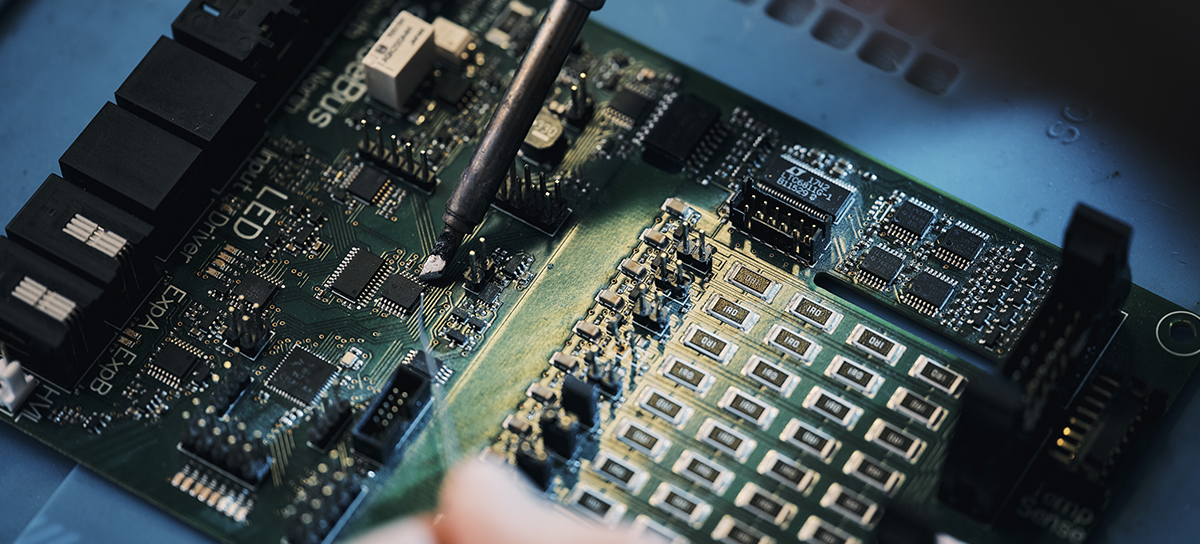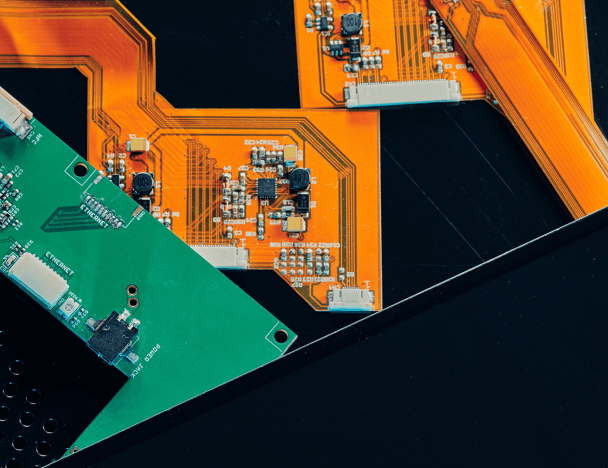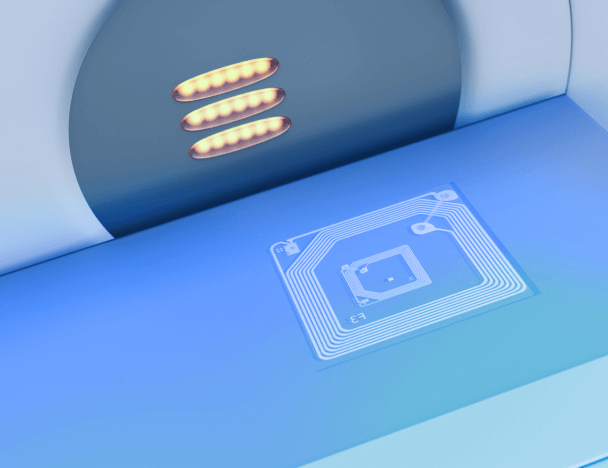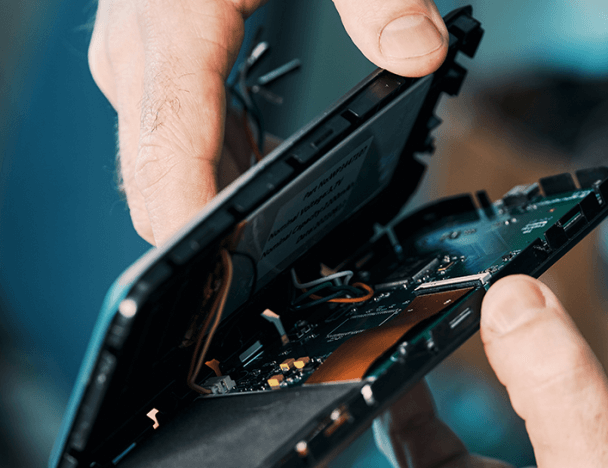This website uses cookies so that we can provide you with the best user experience possible. Cookie information is stored in your browser and performs functions such as recognising you when you return to our website and helping our team to understand which sections of the website you find most interesting and useful.
Differences Between RFID and NFC Systems, their Applications, and Alternatives


Timur Yuldashev
IT Writer, PhD in Philological Sciences

Andrey Solovev
Chief Technology Officer, PhD in Physics and Mathematics
- What is RFID?
- What is NFC?
- The Difference Between RFID and NFC systems
- Coverage Range
- Type of Communication: Unidirectional vs Bidirectional
- Data Transfer Speed and Volume
- Data Types
- Applications of NFC and RFID Systems
- Common Applications of RFID systems
- Common Applications of NFC Systems
- Creative and Unusual Applications of RFID and NFC Systems
- Certification of NFC and RFID Systems
- RFID and NFC Alternatives
- NFC/RFID Software and Hardware Design
- NFC firmware development
- Ordering device
- Geolocation system
- The Cost of RFID and NFC Devices
- 1. Simple system
- 2. Complex system
- Conclusion
Radio frequency identification and near field communication allow devices to exchange data through radio waves. NFC systems are mostly used in contactless payment, while RFID systems find usage in asset and location tracking. Nevertheless, both these technologies can be found in many other systems as well. In this article, we will discuss the key differences between them, their applications, and alternatives. We will also touch upon how much it costs to develop such systems and what certifications they require. And finally, we will share our experience in developing hardware for RFID and NFC-based systems.
- What is RFID?
- What is NFC?
- The Difference Between RFID and NFC systems
- Coverage Range
- Type of Communication: Unidirectional vs Bidirectional
- Data Transfer Speed and Volume
- Data Types
- Applications of NFC and RFID Systems
- Common Applications of RFID systems
- Common Applications of NFC Systems
- Creative and Unusual Applications of RFID and NFC Systems
- Certification of NFC and RFID Systems
- RFID and NFC Alternatives
- NFC/RFID Software and Hardware Design
- NFC firmware development
- Ordering device
- Geolocation system
- The Cost of RFID and NFC Devices
- 1. Simple system
- 2. Complex system
- Conclusion
What is RFID?
RFID stands for radio-frequency identification. It is a wireless communication technology that can uniquely identify objects with radio waves. All RFID systems consist of the following elements:
- Reader (interrogator).
- Tag (transponder).
- Embedded RFID software that stores the received data and provides the correct work of the system.
RFID devices don’t need the tag to be in the line of sight of the reader. Also, RFID readers can read the data from both stationary and moving tags.
What is NFC?
NFC stands for near field communication. This type of wireless communication technology evolved from RFID and can be considered as its fine-tuned, special-purpose subset. While RFID devices are radio transmitters, NFC devices are rather magnetic transmitters.
An NFC system consists of the same functional elements:
- Initiator (reader)
- Target (tag, key fob, sticker, card, etc.)
- Embedded NFC software
In some cases, such systems can be created with off-the-shelf components. But unique solutions will require both hardware and software development. If you consider using these technologies for the benefit of your business, please, contact our team to discuss the details.
The Difference Between RFID and NFC systems
Coverage Range
The read range of a reader depends on the frequency band the device uses and the transceiver power. In civil applications, the range of most RFID devices does not exceed 3-5 meters.
As for near field communication, its reading range does not exceed a few centimeters and must be within a direct line of sight. This, however, makes it difficult to intercept the data transmission.
Type of Communication: Unidirectional vs Bidirectional
RFID technology provides only unidirectional communication. The tag (whether active or passive) sends data to the reader. The reader itself can scan the data but does not store any information.
Each near field communication device can work as both a reader and a tag. Hence, they are capable of unidirectional and bidirectional communication.
Data Transfer Speed and Volume
For near field communication, the maximum data transfer speed does not exceed 424 kbit/s, which is pretty slow. On top of that, a reader can only scan one tag at a time.
RFID readers can scan tags in batches and have higher data transfer speed. Therefore, this technology better suits tasks that involve multiple trackable components.
Data Types
Radio-frequency identification tags can only store simple ID data. NFC tags can carry multiple data types and store more information. Thus, near field communication is more suitable for transmitting payment details, ticket information, etc.
Applications of NFC and RFID Systems
Both NFC and RFID technologies have many applications in different industries.
Common Applications of RFID systems
- Access control. Radio-frequency identification cards and badges are reliable and secure. They can also store enough data for identifying personnel to grant them access to doors, computers, etc.
- Real time location systems. Such systems allow you to track various assets, goods, resources, employees, or customers in real time. They serve different purposes: to measure the staff’s efficiency, to improve the floor plan of your store, to know where and how many valuable resources you have, etc.
- Logistics & supply chains. Active ultra high frequency RFID tags are easy to read when they are moving. As a result, they are often used for tracking vehicles and cargo containers.
- Inventory management. Tracking assets on the point of sales is beneficial to retailers, especially retail chains with multiple stores. RFID technology also makes inventory count much faster.
- Animal tracking. Low-frequency radio waves easily penetrate animal bodies that contain a lot of water. It makes them useful for livestock identification and tracking.
- Marketing. Marketers use RFID technology for creating interactive experiences with advertising posters, smart items, mobile applications, etc.
- Vehicle access. Radio-frequency identification starters, immobilizers, and entry systems protect cars from potential thefts.
- Theft prevention. Retailers attach RFID tags to their goods. You must have seen them in clothes stores. If not deactivated before you leave the place, these tags will trigger an alarm.
- Race timing. Tags are placed on the back of race numbers. It allows the administration to see where each participant is. Also, the tags can tell the exact time participants cross the finish line.
Common Applications of NFC Systems
- Contactless payment. This was one of the first applications of NFC technology. Due to its very short range, such payment transactions are very difficult to intercept.
- Data exchange. Near field communication is capable of two-way communication. Thanks to this feature, two devices can exchange business cards, documents, pictures, etc. Android Beam is an example of such an application.
- Access control. Near field communication is also used for keyless access to vehicles or restricted areas.
- Healthcare. NFC tags find many uses in healthcare. They simplify check-ins and payments, make it easier to track patients’ status and records, check schedules, and access the necessary equipment. Such tags are also used for gathering diagnostics information from different sensors.
- Smart ticketing. Similar to access control, NFC tags are used to grant access to buses, airplanes, movie theaters, concerts, and so on.
- Manufacturing and logistics. In manufacturing industries, NFC tags can be used for product identification at different stages: production, packaging, shipment, etc. They can also be useful for logistics.
- Marketing. As many smartphones can read NFC tags, marketers widely use this technology to advertise products and events or to attract potential customers to websites, videos, and blogs. Reading NFC tags also allows you to get coupons and special offers, or simply get information about a product or event.
Creative and Unusual Applications of RFID and NFC Systems
The possibilities of RFID and NFC devices are almost limitless. Many businesses find unexpected ways to benefit from these technologies. If you too have a brilliant idea, contact our team and we will help you bring it to life. Here are several examples.
- Luggage tracking. Nowadays, some airline and cruise line companies attach RFID tags to luggage. Readers fixed at multiple checkpoints scan them and let the personnel know where the bags are.
- Smart shelves. Some American supermarkets use shelves with NFC tags. Customers can get discounts or special offers with their smartphones. The tags also provide links to relevant content: instructional videos, recipes, the location of other stores, etc.
- Smart golf balls. RFID tags are placed inside golf balls, making it easier to find them.
- Document tracking. Some businesses have to store valuable information in hard copy – for example, hospitals, law and accountant firms. Some of them use RFID tags to track the location of the most important papers.
- Laundry. Waterproof NFC tags are widely used in industries and businesses dealing with large numbers of clothes: logistics, dyeing industry, and facilities that use uniforms. This way, one can track individual items, how many times it was washed, how old it is, etc.
- Anti-counterfeiting labels. Some retailers use fragile NFC tags. They contain the information about the product: production batch, date, sales channel, etc. Such tags break easily when you try to remove them. So, if it’s there, customers can be sure the product is not fake.
Some of the unique applications of these technologies also include microchipping employees with RFID tags for access control, tracking food “from production to plate”, using tags in casino chips for behavior tracking, anti-swipe tickets in amusement parks and stadiums, pet tracking, LED-guided order picking in warehouses, and more.
Certification of NFC and RFID Systems
Like all other electrical appliances, RFID and NFC devices must comply with various standards and regulations. They must successfully pass corresponding certification procedures to be allowed in different markets.
Companies that develop RFID or NFC-based devices will most likely have to certify them with the FCC (for the US market) and the CE (for the European market). You can read more about these and other regulations in our article on consumer electronics certification in the US and EU.
NFC and RFID devices consist of radio transmitters, receivers, and transponders. Therefore, such systems are regulated by the FCC part 15. Note that UHF RFID tags and passive HF RFID tags are exempted from FCC certification, as they do not emit energy.
As for the European Union, such systems require CE RED testing. The standards such systems must comply with include but are not limited to:
- ETSI EN 300 440 (radio equipment that uses 1-40 GHz);
- ETSI EN 300 330 (radio equipment that uses 9 kHz - 25 MHz and inductive loop systems in the frequency range 9 kHz - 30 MHz);
- ETSI EN 300 220 (short range devices that operate at 25-1,000 MHz);
- ETSI EN 300 328 (wideband transmission systems operating in the 2,4 GHz band).
Note that the frequency ranges allowed to be used by short-range transmitters differ from country to country. For instance, in the US, UHF RFID systems are allowed to use 902-928 MHz. The same systems in Europe are only allowed to use 865-868 MHz.
Often, this problem is solved by designing the system to incorporate all frequencies used around the world (within a certain frequency band).
RFID and NFC-enabled systems may also require such certifications as UL (may be required by retailers), California Proposition 65, ATEX, IECEx, IP, IK, ARC, and more.
Near field communication devices can also be NFC-Forum-certified. This certification is optional but proves that the device will interoperate with other NFC-Forum-certified models. You can learn more about NFC Forum Certification Program by following this link.
RFID and NFC Alternatives
Depending on what kind of system you want to develop, you can pick from a number of NFC and RFID alternatives. Many of them can be used for similar or identical applications. The following examples can be regarded as pure NFC and RFID alternatives used for asset tracking and inventory management.
Barcodes were used to track and store information about items before the new technologies arrived. Compared to radio-frequency identification or near field communication, they have a number of serious disadvantages. An optical scanner can only read one barcode at a time and must be in the line of sight. Pieces of paper can get dirty or torn off. The amount of data on a barcode is very limited.
QR codes use both vertical and horizontal space to encode information. So, they contain more data than a barcode. QR codes have the same disadvantages, but, just like barcodes, they are cheap and don’t require expensive equipment.
Wired ID chips. Another alternative is to use an ID chip that cannot be read remotely: smart cards, touch memory devices, etc. The chip will transmit the ID information only after the contacts are closed. Such systems are more secure.
For location tracking, one can use the following technologies as RFID or NFC alternatives. Note that in some cases, they can be a cheaper or a simpler option. But as a rule, using them for this task is somewhat exotic.
Wi-Fi finds more use in home automation systems rather than in tracking and management solutions. Wi-Fi has a longer range, but unlike passive RFID tags, Wi-Fi solutions require a lot of energy. The biggest advantage of a Wi-Fi-based system is that one can use an existing infrastructure instead of building a new one. But creating infrastructure from scratch can be very costly.
BLE-based systems find use in home entertainment, healthcare, fitness, and other spheres. It can be used in location tracking but faces similar problems as Wi-Fi. Despite long-lasting battery life, one will still have to regularly replace the batteries in the beacons. Also, you will have to create the infrastructure from scratch.
Zigbee and Z-Wave are wireless communication protocols that have many common features. They are mostly used in home automation to create a mesh network and provide a strong connection between smart devices. They both feature low energy consumption. Nevertheless, they lack the autonomy and compactness of passive RFID systems.
Unlike Wi-Fi, BLE, and similar beacons, RFID and NFC tags can be very small and flexible. It makes them suitable for tracking hundreds and thousands of small assets. Besides, passive tags don’t require energy from batteries. The alternatives mentioned above can transfer larger amounts of data, which makes them suitable for home automation. On the other hand, asset tracking systems don’t need to transmit that much information. Also, RFID and NFC usually don’t require complex security methods.
Nevertheless, R&D on RFID and NFC alternatives can prove them to be better options for certain situations. Our team has worked with all these technologies and can adapt them for your asset tracking project if they find it reasonable. Contact us directly to discuss the system you want to create.
NFC/RFID Software and Hardware Design
The following examples describe how near field communication can be used for different purposes.
NFC firmware development
One of our customers was developing a smart home automation system. Our job was to create circuit designs for the system’s control panel. The scope of work also included firmware and software development, as well as kernel and driver development.
Among other things, the system was supposed to have an NFC module that could read NFC cards for access control. The original driver for the NFC reader didn't work with the Linux-Sunxi kernel. So, our task was to adapt the driver to run on the legacy system.
In this particular case, NFC firmware development was one of the main challenges of the project.
Ordering device
This use case demonstrates how near field communication can support a system based on a different technology.
The customer was developing a mesh network for a restaurant. The network consists of multiple devices. Their primary function is to send a signal to a waiter when activated. Our job was to develop software and firmware for the network.
From time to time, the staff has to recharge some of the devices and replace them with fully charged ones. As a result, the same device can be placed on different tables. So, one has to adjust the device’s settings, so that it can understand what table it is on. The easiest way to do it was to use NFC tags.
NFC tags were fixed on each table. The ordering devices were equipped with NFC readers. When placed on the tag, they read the information on the tag and change the settings automatically.
As you can see, in this case, near field communication simplifies the work of the system.
Geolocation system
In this example, NFC technology was used for sports and entertainment. The customer wanted a system to track participants of orienteering events and location-based games. In this project, NFC tags replaced control points. By reading the tag with a smartphone, participants can prove that they have visited the point.
Initially, the client planned to use NFC-enabled smartphones as readers. But later, he asked us to develop a special NFC tracker for this system. So, in this project, the team mostly focused on NFC hardware design.
Unlike a smartphone, the tracker cannot be used for cheating. Thus, it gives participants even chances. The team also made it water and shockproof. And finally, the tracker performs a number of additional functions:
- It tracks the participant’s location in real time with an accelerometer and a gyroscope. The data is transferred to the administrators.
- It has a screen that can display hints. It can also warn the participants if they have left the event area.
- The tracker also has an emergency button that sends a signal to the administration.
Implementing near field communication in this system was not difficult. However, in this particular case, the team had to take into account the harsh environmental conditions in which the system is supposed to work. It is a common issue for RFID and NFC systems used outdoors.
Read our article on RFID and NFC development to learn more technical details about how engineers design such systems.
The Cost of RFID and NFC Devices
The cost of NFC or RFID development can vary a lot. It depends on such factors as the size of the system, its complexity, the number and complexity of the issues designers will have to solve, etc. Another factor is whether developers can use off-the-shelf components or need to design original ones. The design of the casing can add up to the cost as well. Finally, hiring an electronics design company situated in North America or Europe will cost more than hiring a firm located in other regions.
The following description is a very rough estimation of how much the device under development can cost. The price does not include the cost of development.
1. Simple system
Simple NFC or RFID hardware will not require a computing system (microprocessor or microcontroller). In this case, there are two options.
A) Instead of designing an original NFC module, the team can adapt the ones sold in components stores. It will speed up the development process, but the cost of the system will most likely rise. This solution better suits prototyping or small-volume manufacturing. For instance, NFC-NTAG modules from TechNexion cost $4 each.
B) The other option is to design an original module based on a specialized transponder, for example, Microchip Technology or STMicroelectronics. The development will take longer, as the team will have to design a custom printed circuit board. But the final cost of the device should be lower compared to off-the-shelf modules.
An original module will include the following components:
- A transponder (IC), $0.306.
- A number of passive components for the transponder, <$0.5.
- A simple 2-layer PCB, ~$0.45.
- Circuit board assembly, ~$1.2.
- We can form a trace antenna on the PCB or buy an off-the-shelf antenna. Molex 146236-0051 will cost $0.382.
The total cost of the module should not exceed $2.838.
2. Complex system
If the device does require a computing system, we will need more complex components.
A) One particular option is to use an off-the-shelf module. A TnL-FIT203 IoTize, for example, will cost $26.14. Just like with simpler systems, this approach will take less time, but the device will cost more.
B) If the system already uses a computing system, we can simply add a dynamic RFID or NFC tag to it. Such a tag serves as a bridge between the radio (RFID or NFC) and wired internal interfaces of the system (usually I2C). In this case, the module will require the following components:
- A dynamic tag (IC), <$0.36.
- A number of passive components, <$0.5.
- If it is impossible to use a trace antenna on the main PCB, we can make a daughter board. It will cost another $0.45. In a confined space, the device may require a flexible PCB which will cost $3.5.
- If the tag is placed on a daughter PCB, circuit board assembly will cost $1.2 and $4 if we use a flexible PCB.
- We can use a trace antenna or buy an off-the-shelf model that will cost $0.382.
The total cost of the module should not exceed $8.742.
C) If the system under development is based on RFID or NFC but does not have special requirements related to the microcontroller, it is recommended to use a microcontroller with an integrated RFID/NFC interface. For example, LPC8N04FHI24E. In this case, the cost of the device will include:
- A microcontroller with integrated RFID/NFC, ~$6.7.
- A number of passive components, <$1.0.
- A 2-layer PCB with a trace antenna, $0.6; or a flexible PCB, $4.
- Circuit board assembly: $1.5-$4.5.
- If using a trace antenna is not an option, an off-the-shelf antenna will cost $0.382.
The total cost should not exceed $16.582.
Conclusion
RFID and NFC systems use short-range communication to read the ID information on tags. They find use in many spheres of life: contactless payment transactions, asset tracking, real time location systems, access control, retail, marketing, and more. Most of these applications help businesses track their products, tools, personnel, and other assets, making them more efficient.
NFC devices can read data from a few centimeters only, are capable of bidirectional communication, and can read only one tag at a time at a relatively low speed. On the other hand, near field communication tags can carry multiple data types. RFID tags can only carry simple ID information but have a longer range. They are only capable of unidirectional communication but have higher data transfer speed.
When designing RFID or NFC-based devices, one can either use off-the-shelf components or develop an original system. Our team can analyze your idea to offer the most suitable and reasonable solution. Contact us to talk about your project.
Share this article


Related
materials


A Control Panel for IoT-Based Smart Home Automation System
Within the scope of the project, the team developed three PCBs, a custom Linux image, and drivers for different modules...
LEARN MORE
LEARN MORE

Custom RFID and NFC Device Development: Theory and Practice
How do RFID and NFC Technologies Work? Radio-frequency identification (RFID) is a wireless communication technology that uses radio waves to...
LEARN MORE
LEARN MORE

What Makes Electronics Prototyping so Important for Successful Product Development?
Electronics prototyping answers a range of crucial questions, such as how to solve a particular engineering problem, how to do...
LEARN MORE
LEARN MORE


